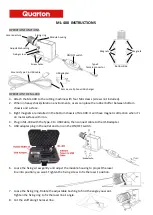
Remote Commands
R&S
®
ZNH
200
User Manual 1334.5985.02 ─ 02
Example
–
[SENSe:]BANDwidth|BWIDth[:RESolution]
or
SENS:BAND:RES
is equivalent to
BAND
Parameters in square brackets can be incorporated optionally in the command
or omitted as well
–
MMEMory:NETWork:MAP<string>,<string>[,<string>,<string>,
<boolean>]
Entries in square brackets are optional or can be omitted.
●
Braces { }
Parameters in curly brackets are optional and can be inserted once or several
times, or omitted.
Example
–
SENSe:LIST:FREQuency <numeric_value>{,<numeric_value>}
The following are valid commands:
SENS:LIST:FREQ 10
SENS:LIST:FREQ 10,20
SENS:LIST:FREQ 10,20,30,40
Numeric Suffix
If a device features several functions or features of the same kind, e.g. inputs, the
desired function can be selected by a suffix added to the command. Entries without
suffix are interpreted like entries with the suffix 1. Optional keywords must be specified
if they select a function with the suffix.
Example:
SYSTem:COMMunicate:SERial2:BAUD 9600
This command sets the baud rate of a second serial interface.
Suffix counting
In case of remote control, suffix counting may differ from the numbers of the corre-
sponding selection used in manual operation. SCPI prescribes that suffix counting
starts with 1. Suffix 1 is the default state and used when no specific suffix is specified.
Some standards define a fixed numbering, starting with 0. With GSM, for instance,
slots are counted from 0 to 7. In the case of remote control, the slots are selected with
the suffixes 1 to 8. If the numbering differs in manual operation and remote control, it is
indicated with the respective command.
12.4.1.3
Overview of Syntax Elements
The following table offers an overview of the syntax elements.
SCPI Command Structure and Syntax
















































